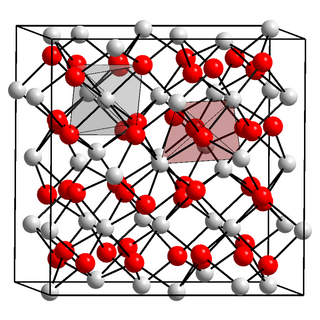
Indium is a chemical element; it has symbol In and atomic number 49. It is a silvery-white post-transition metal and one of the softest elements. Chemically, indium is similar to gallium and thallium, and its properties are largely intermediate between the two. It was discovered in 1863 by Ferdinand Reich and Hieronymous Theodor Richter by spectroscopic methods and named for the indigo blue line in its spectrum.

Indium antimonide (InSb) is a crystalline compound made from the elements indium (In) and antimony (Sb). It is a narrow-gap semiconductor material from the III-V group used in infrared detectors, including thermal imaging cameras, FLIR systems, infrared homing missile guidance systems, and in infrared astronomy. Indium antimonide detectors are sensitive to infrared wavelengths between 1 and 5 μm.

Indium nitride is a small bandgap semiconductor material which has potential application in solar cells and high speed electronics.
Indium (49In) consists of two primordial nuclides, with the most common (~ 95.7%) nuclide (115In) being measurably though weakly radioactive. Its spin-forbidden decay has a half-life of 4.41×1014 years, much longer than the currently accepted age of the Universe.

An infrared detector is a detector that reacts to infrared (IR) radiation. The two main types of detectors are thermal and photonic (photodetectors).

Copper indium gallium (di)selenide (CIGS) is a I-III-VI2 semiconductor material composed of copper, indium, gallium, and selenium. The material is a solid solution of copper indium selenide (often abbreviated "CIS") and copper gallium selenide. It has a chemical formula of CuIn1−xGaxSe2, where the value of x can vary from 0 (pure copper indium selenide) to 1 (pure copper gallium selenide). CIGS is a tetrahedrally bonded semiconductor, with the chalcopyrite crystal structure, and a bandgap varying continuously with x from about 1.0 eV (for copper indium selenide) to about 1.7 eV (for copper gallium selenide).
A gallium scan is a type of nuclear medicine test that uses either a gallium-67 (67Ga) or gallium-68 (68Ga) radiopharmaceutical to obtain images of a specific type of tissue, or disease state of tissue. Gallium salts like gallium citrate and gallium nitrate may be used. The form of salt is not important, since it is the freely dissolved gallium ion Ga3+ which is active. Both 67Ga and 68Ga salts have similar uptake mechanisms. Gallium can also be used in other forms, for example 68Ga-PSMA is used for cancer imaging. The gamma emission of gallium-67 is imaged by a gamma camera, while the positron emission of gallium-68 is imaged by positron emission tomography (PET).

Indium(III) oxide (In2O3) is a chemical compound, an amphoteric oxide of indium.
Indium(III) sulfide (Indium sesquisulfide, Indium sulfide (2:3), Indium (3+) sulfide) is the inorganic compound with the formula In2S3.
Indium (111In) altumomab pentetate (INN) is a mouse monoclonal antibody linked to pentetate which acts as a chelating agent for the radioisotope indium-111. The drug is used for the diagnosis of colorectal cancer but has not been approved for use.
Indium (111In) capromab pendetide is used to image the extent of prostate cancer. Capromab is a mouse monoclonal antibody which recognizes a protein found on both prostate cancer cells and normal prostate tissue. It is linked to pendetide, a derivative of DTPA. Pendetide acts as a chelating agent for the radionuclide indium-111. Following an intravenous injection of Prostascint, imaging is performed using single-photon emission computed tomography (SPECT).
Indium (111In) igovomab was a mouse monoclonal antibody for the diagnosis of ovarian cancer.
Indium (111In) satumomab pendetide is a mouse monoclonal antibody which is used for cancer diagnosis. The antibody, satumomab, is linked to pendetide, a derivative of DTPA. Pendetide acts as a chelating agent for the radionuclide indium-111.
Immunoscintigraphy is a nuclear medicine procedure used to find cancer cells in the body by injecting a radioactively labeled antibody, which binds predominantly to cancer cells and then scanning for concentrations of radioactive emissions.

An octreotide scan is a type of SPECT scintigraphy used to find carcinoid, pancreatic neuroendocrine tumors, and to localize sarcoidosis. It is also called somatostatin receptor scintigraphy (SRS). Octreotide, a drug similar to somatostatin, is radiolabeled with indium-111, and is injected into a vein and travels through the bloodstream. The radioactive octreotide attaches to tumor cells that have receptors for somatostatin. A gamma camera detects the radioactive octreotide, and makes pictures showing where the tumor cells are in the body, typically by a SPECT technique. A technetium-99m based radiopharmaceutical kit is also available.

Indium(III) fluoride or indium trifluoride is the inorganic compound with the formula InF3. It is a white solid.
Indium-111 (111In) is a radioactive isotope of indium (In). It decays by electron capture to stable cadmium-111 with a half-life of 2.8 days. Indium-111 chloride (111InCl) solution is produced by proton irradiation of a cadmium target in a cyclotron, as recommended by International Atomic Energy Agency (IAEA). The former method is more commonly used as it results in a high level of radionuclide purity.
The indium white blood cell scan is a nuclear medicine procedure in which white blood cells are removed from the patient, tagged with the radioisotope Indium-111, and then injected intravenously into the patient. The tagged leukocytes subsequently localize to areas of relatively new infection. The study is particularly helpful in differentiating conditions such as osteomyelitis from decubitus ulcers for assessment of route and duration of antibiotic therapy.
Indium (111In) biciromab was a drug targeting fibrin, a protein involved in the clotting of blood. It was the Fab' fragment of a mouse monoclonal antibody labelled with the radioisotope indium-111 for the diagnosis of thromboembolism, but was withdrawn during clinical trials.

Pendetide (GYK-DTPA) is a chelating agent. It consists of pentetic acid (DTPA) linked to the tripeptide glycine (G) – L-tyrosine (Y) – L-lysine (K).








